- Places
- Plans
- Itineraries
- Experiences
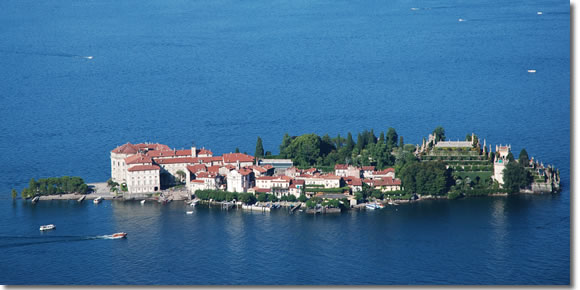
Isola Bella. (Photo by Mbdortmund)
The most famous and fabulous of the islands is Isola Bella, an immaculately landscaped garden of an island named after the wife of one of the Borromeo, Isabella.
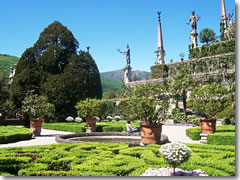
The gardens at Isola Bella. The island has been completely transformed into a terraced pyramid of formal gardens hemmed by lined by statue-topped balustrades and clipped lawns strutting with pairs of much-photographed white peacocks.

The tapestries gallery on Isola Bella. (Photo courtesy of Boromeo Tourism.) Isola Bella is dominated by the vast Borromeo Palace, started in the 17th-century but not finished until 1959. The palace's sumptuous rooms are filled with inlaid dressers, ornately stuccoed ceilings, antique armaments, Murano chandeliers, classic theatre puppets, and some quite fine paintings.
There is also a set of 16th-century Flemish tapestries based on that most popular theme for medieval tapestries: the unicorn, which also happens to be the Borromeo family's heraldic totem.
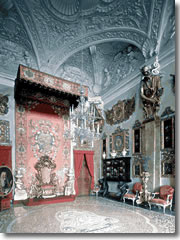
The Throne Room on Isola Bella. (Photo courtesy of Boromeo Tourism.Many rooms have an artistic theme: one is filled with large 17th-century mythological scenes by Luca Giordano, another devoted to oddly-shaped pastoral compositions by 18C rococo master Francesco Zuccazelli. Pannini's patented 18th century Romantic Roman ruins decorate a third.
Recently reopened to the public for the first time since the 1930s are the Sala del Trono (Throne Room), a rococo riot centered upon a gilded throne carved in the 18th century and backed by a canopy of pink silk; and the equally over-the-top baroque Sala della Regina (Queen's Room), where King Carlo Felice and Queen Maria Cristina of Piemonte sojourned for September, 1828.
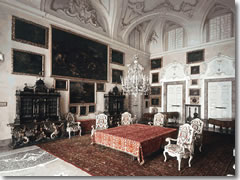
The Music Room on Isola Bella. (Photo courtesy of Boromeo Tourism. The Sala di Musica is the most famous room, housing a collection of antique instruments along with, on the right walls, landscapes by Pietro Tempesta donated by the artists after the Borromei gave him refuge here in 1685 while he fought off some trumped-up murder charges. The left wall has The Forge of Vulcan by Jacopo da Bassano, but the art isn't what makes this room famous.
It was here, on April 11, 1935, that Mussolini met with Pierre Laval of France and James Ramsey MacDonald of Britain in the so-called Conference of Stresa, a last-ditch attempt to stave off World War II by allying together against Hitler.
Negotiations failed because the France and England refused to recognize Mussolini's recent conquest of Ethiopia. Mussolini later found Hitler's overtures to be more in tune with his own delusions of grandeur, and Italy entered World War II on the side of the Axis.

The Grottoes on Isola Bella. (Photo courtesy of Boromeo Tourism. Clearly falsified caves were all the rage in the 18th century—a nod to an ancient Roman fashion just then being rediscovered. These "grottoes" were decorated with a sort of grand, intricately detailed pebble-dashing in black-and-white patterns dripping from every surface.
These north-facing rooms were the palace's coolest in the summer, and are filled with a hodgepodge of tiny collections of corals, Roman and Etruscan antiquities, and 16th century saddles.
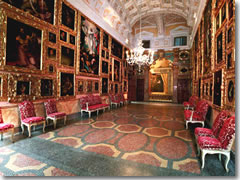
The painting gallery on Isola Bella. (Photo courtesy of Boromeo Tourism. The Galleria dei Quadri painting gallery (also called the Galleria del General Berthier) is yet another section of the palace recently reopened to the public.
Its walls are densely packed with more than 2,000 paintings—most mediocre (lots of copies of Old Masters), but impressive in aggregate, and interesting for being displayed as closely as possible to how they were in the 1920s.
The gallery is open 9am–1pm and 1:30–5pm. Admission is an extra €3.
Isola Bella
Isole Borromeo, Stresa, Lago Maggiore
tel. +39- 0323-30-556
www.borromeoturismo.it
Open 9am–5:30pm
Open
last Sat in March–last Sun in Oct
You can also get info in the tourist offices of Stresa (ferry docks, Piazza Marconi 16, tel. +39-0323-31-308, www.stresaturismo.it and www.comune.stresa.vb.it).
Take a tour: If you'd prefer to take a day trip of Lake Maggiore and the Borromean Islands from Milan with an expert guide, consider booking one through our partners at Viator.com:
Hotels on the Borromean Islands
First get yourself to Stresa.
By the Stresa waterfront in the center of town is a dock where you can grab a ferry the leaves frequently, roughly every half hour in summer (tel. +39-800-551-801, www.navigazionelaghi.it).
The ride is brief: Isola Bella is just 5 min. from Stresa in one direction, and 5 min. from Isola Superiore in the other (from which it is 20 more minutes to Isola Madre, with an intermediate stop in Baveno).
One-way ferry tickets from Stresa to Isola Bella cost €3.50 (from Isola Superiore it's €2; from Isola Madre it's €3.80). If you're only visiting Isola Bella and Isola Madre, individual tickets are the cheapest way to go, running you €11.80 total.
If, however, you think you may also want to hop out at Isola Superiore dei Pescatori (say, for lunch), it will be cheaper to buy an unlimited ride biglietto di libera circolazione—you want it for "tratta cinque" ("zone 5"), which costs €12.20.
You can get admission to just one island (Isola Bella is €13, Isola Madre is €11), both islands together (€18), or to both islands plus the Rocca Borromeo in Angera (€21.50 for all three; €8.50 for the castle by itself).
Definitely take the audioguide to learn more about the island.
Share this page
Search ReidsItaly.com
Isola Bella
Isole Borromeo, Stresa, Lago Maggiore
tel. +39- 0323-30-556
www.borromeoturismo.it
Open 9am–5:30pm
Open
last Sat in March–last Sun in Oct
Hotels on the Borromean Islands